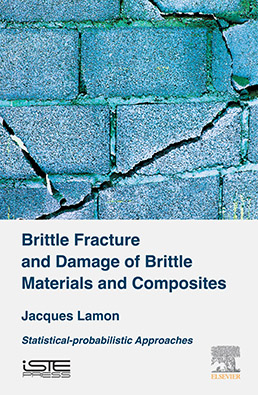
This book focuses on probabilistic approaches to brittle fracture with the emphasis placed on those approaches which consider the flaws as physical entities, and more particularly the approach based on the multiaxial elemental strength concept for multiaxial problems.
The author covers issues such as the significance of flaw severity for the fracture of materials; the main statistical-probabilistic approaches to brittle fracture; the notion of effective volume or surface for the comparison of strengths under various stress-states, the use of these methods for quantification of effects on failure strength induced by flaw populations (such as effects of size and loading mode); the methods of estimation of statistical parameters that define flaw strength distributions; the application of probabilistic-statistical approaches to component design and reliability; the use of these approaches for predictions of failure; and then extends these approaches to damage and failure of continuous fiber-reinforced ceramic matrix composites.
Several examples of failure predictions are discussed that should be helpful to the readers. These case studies can be useful for better understanding or for solving problems. Most examples come from high-performance ceramics, which represent the family of brittle materials, and exemplify the type of fracture problems encountered with brittle materials. The book tackles theoretical and experimental issues and proposes concepts, tools and methods for solving problems of fracture or design. Thus, for many brittle materials, their introduction into industrial systems requires appropriate approaches that are not only efficient in predicting the conditions of fracture or damage in service, but also the associated risk of occurrence of these conditions.
1. Flaws in Materials.
2. Statistical-Probabilistic Approaches to Brittle Fracture: The Weibull Model.
3. Statistical-Probabilistic Theories Based on Flaw Size Density.
4. Statistical-Probabilistic Theories Based on Flaw Strength Density.
5. Effective Volume or Surface Area.
6. Size and Stress-State Effects on Fracture Strength.
7. Determination of Statistical Parameters.
8. Computation of Failure Probability: Application to Component Design.
9. Case Studies: Comparison of Failure Predictions Using the Weibull and Multiaxial Elemental Strength Models.
10. Application of Statistical-Probabilistic Approaches to Damage and Fracture of Composite Materials and Structures.
Jacques Lamon is Director of Research at CNRS (National Centre of Scientific Research) and the Laboratory for Mechanics and Technology (LMT) at Ecole Normale Supérieure Cachan (Paris, France). He is the author/editor of 7 books, 13 invited chapters, 14 conference proceedings, and three journal special issues. In addition, he has written over 300 articles on ceramics and ceramic matrix composite reliability and mechanical